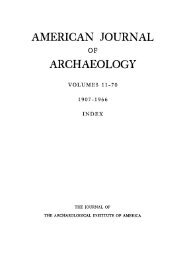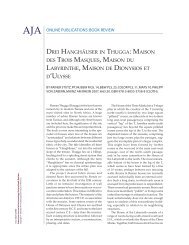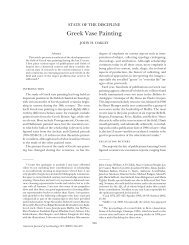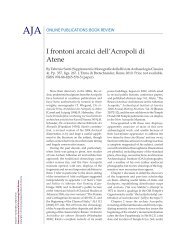Free PDF - American Journal of Archaeology
Free PDF - American Journal of Archaeology
Free PDF - American Journal of Archaeology
Create successful ePaper yourself
Turn your PDF publications into a flip-book with our unique Google optimized e-Paper software.
<strong>American</strong> <strong>Journal</strong> <strong>of</strong> <strong>Archaeology</strong> Online Book Review<br />
<strong>of</strong> Cypro-Archaic and Cypro-Classical date,<br />
laid in the late fourth century B.C. as filling<br />
for a road that passed through the ruined<br />
gateway. In the South Area, where greater soil<br />
depth provided better preservation, an area <strong>of</strong><br />
housing was found. The process <strong>of</strong> excavation<br />
is well illustrated by text photographs. Sections<br />
and plans are included as inserts in a pocket<br />
in the back cover, and synoptic tables provide<br />
a schematic presentation <strong>of</strong> strata and find<br />
distribution.<br />
In part 2 Adelman provides a brief treatment<br />
<strong>of</strong> the history and significance <strong>of</strong> the<br />
site. He notes the need for a reassessment <strong>of</strong><br />
the Sinda material in light <strong>of</strong> recent ceramic<br />
studies but unfortunately makes no attempt<br />
to do so. Addressing the question <strong>of</strong> who<br />
built Sinda and why, it is suggested that the<br />
settlement controlled the only crossing <strong>of</strong> the<br />
Pedieos River on the copper route from Idalion<br />
and Athienou to Enkomi, perhaps exacting<br />
tolls from travelers and traders. Adelman suggests<br />
that the site was surrounded by a double<br />
wall, with the remains excavated by Furumark<br />
belonging to the inner system. Difficulties in<br />
distinguishing catastrophe material from prefloor<br />
fills are noted but not considered overly<br />
problematic, and life at Sinda is conventionally<br />
described as lively and prosperous, the inhabitants<br />
engaged in agriculture, food production,<br />
craft activities, and bull worship.<br />
It is left, indeed, to Paul Åström to take up<br />
the challenge <strong>of</strong> reviewing Sinda and its two<br />
destruction levels in the light <strong>of</strong> more recent<br />
discoveries and within the highly contested<br />
context <strong>of</strong> the history and chronology <strong>of</strong> Late<br />
Cypriot III. Åström suggests a lowering <strong>of</strong> the<br />
dates proposed by Furumark in line with a<br />
lowering <strong>of</strong> the end <strong>of</strong> Mycenaean IIIB. Thus,<br />
Period I, which produced Mycenaean IIIB<br />
pottery, ends ca. 1190/1180 B.C., Period II in<br />
ca. 1150/1140, and Period III in ca. 1110/1100<br />
B.C. This lowered chronology raises the possibility<br />
that the first destruction at Sinda was<br />
brought about by the Sea Peoples and not,<br />
as Furumark proposed, by Greek settlers.<br />
Åström’s own view is that both destructions<br />
were caused by pirates and adventurers consisting<br />
<strong>of</strong> Mycenaeans and groups from other<br />
areas, or possibly by conflict between Cypriots<br />
themselves. Whatever the case, this final<br />
publication <strong>of</strong> Sinda will no doubt give rise<br />
to renewed debate about events in Cyprus in<br />
the 12th century and, as Åström notes, further<br />
fuel discussion <strong>of</strong> the radical low chronology<br />
proposed by some scholars for Palestine via<br />
<strong>of</strong>t-noted links between Sinda Mycenaean<br />
IIIC1b and Philistine pottery.<br />
Part III contains extensive find catalogues<br />
with summary indexes and a listing <strong>of</strong> all<br />
classes <strong>of</strong> material with accompanying highquality<br />
black-and-white illustrations and line<br />
drawings. While some items (e.g., a stamp<br />
seal) are discussed in detail, most appear only<br />
as catalogue entries with typological attribution<br />
and some comparanda. Contextual data<br />
and Furumark’s views on ceramic style and<br />
chronology are reported where relevant. Sherd<br />
counts by ware and stratigraphic context and<br />
other distributional and statistical data are<br />
further presented in part IV and an appendix.<br />
The animal remains are reported by Gejvall,<br />
translated from a Swedish original <strong>of</strong> 1951.<br />
Adelman is to be commended for taking<br />
on an extremely difficult task and achieving<br />
a fine result for which scholars <strong>of</strong> the Cypriot<br />
Bronze Age have cause to be grateful. The<br />
volume lacks a contemporary reading <strong>of</strong> the<br />
ceramic evidence and were it not for the important<br />
contribution by Åström would also<br />
be missing a serious analysis <strong>of</strong> the historical<br />
significance <strong>of</strong> Sinda. It is clear, however, that<br />
Adelman’s main objective was to retrieve and<br />
present the basic stratigraphic, architectural,<br />
and artifactual data, and he has done this in<br />
full and painstaking detail. In making the primary<br />
data available to other scholars, he has<br />
acquitted the primary obligation <strong>of</strong> the original<br />
excavator and ably fulfilled the demands<br />
and responsibilities <strong>of</strong> a collaborative task for<br />
which few <strong>of</strong> us would have had either the<br />
courage or patience.<br />
ARCHAEOLOGy PROGRAM<br />
LA TROBE UNIVERSITy<br />
BUNDOORA, VICTORIA 3083<br />
AUSTRALIA<br />
Jennifer M. Webb








